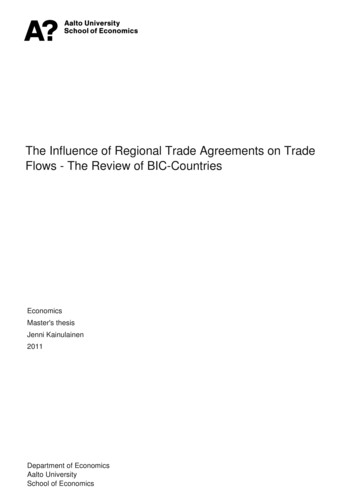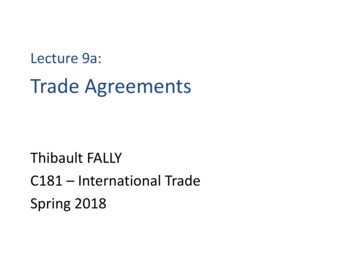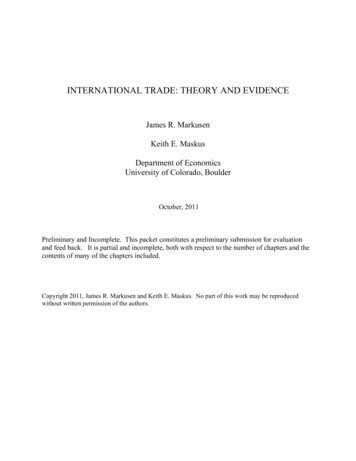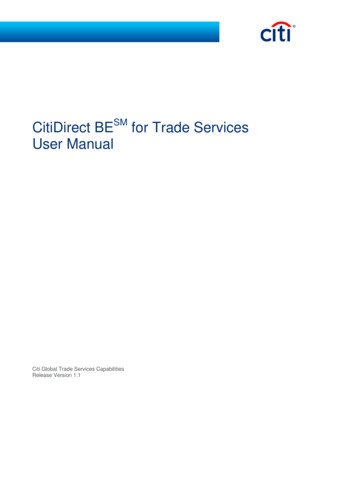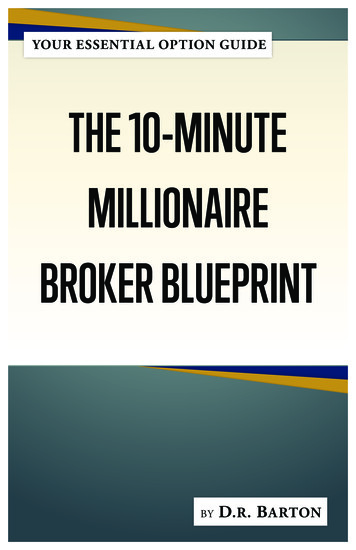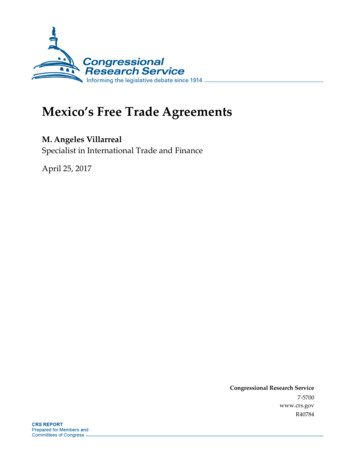
Transcription
How I Trade for a LivingI
.WILEY ONLINE TRADING FOR A LIVINGElectronic Day Trading to Win/Bob Baird and Craig McBurneyDay Trade Online/Christopher A.FarrellTrade Options Online/George A. FontanillsElectronic Day Trading 101/Sunny J. HarrisHow I Trade for a Living/GarySmithII
.How I Trade for a LivingGary SmithIII
.This book is printed on acid-free paper.Copyright 2000 by Gary Smith. All rights reserved.Published by John Wiley & Sons, Inc.Published simultaneously in Canada.No part of this publication may be reproduced, stored in a retrieval system or transmitted in any formor by any means, electronic, mechanical, photocopying, recording, scanning or otherwise, except aspermitted under Sections 107 or 108 of the 1976 United States Copyright Act, without either theprior written permission of the Publisher, or authorization through payment of the appropriate percopy fee to the Copyright Clearance Center, 222 Rosewood Drive, Danvers, MA 01923, (978) 7508400, fax (978) 750-4744. Requests to the Publisher for permission should be addressed to thePermissions Department, John Wiley & Sons, Inc., 605 Third Avenue, New York, NY 10158-0012,(212) 850-6011, fax (212) 850-6008, E-Mail: PERMREQ@WILEY.COM.This publication is designed to provide accurate and authoritative information in regard to the subjectmatter covered. It is sold with the understanding that the publisher is not engaged in renderingprofessional services. If professional advice or other expert assistance is required, the services of acompetent professional person should be sought.Library of Congress Cataloging-in-Publication Data:Smith, Gary, 1947 Apr. 21–How I trade for a living / Gary Smith.p. cm.—(Wiley online trading for a living)Includes bibliographical references and index.ISBN 0-471-35514-3 (cloth : alk. paper)1. Electronic trading of securities. 2. Investments. I. Title.II. Series.HG4515.95.S57 2000332.64'0285—dc2199-38492Printed in the United States of America10 9 8 7 6 5 4 3 2 1IV
.Nicholas Darvas.Your trading methodology had a big impacton an impressionable 14-year-old in 1961.Bruce Babcock.I will be forever appreciativeof everything you did for me.My parents, Sidney and Esther Smith.And, of course, Sandy and the gang—Bandit, Whitney, Beige, Lover Girl, Samson,Tomas, and King.V
ContentsAcknowledgmentsixPrologueA Typical Trading Day1Introduction5Chapter 1Help for a Desperate Trader9Chapter 2Dreams of Easy Money17Chapter 3The Futures Market Beckons23Chapter 4Almost Down for the Count31Chapter 5Putting it All Together41VI
Chapter 6Why the Stock Market?45Chapter 7Trading is a Profession51Chapter 8Perceptual Trading Filters61Chapter 9My Favorite Indicators67Chapter 10Technical Indicators91Chapter 11Monthly Seasonality103Chapter 12The Nitty-Gritty of Trading111Chapter 13Money Management151Chapter 14Trading Mutual Funds155Chapter 15Trading Junk Bond Funds183Chapter 16Trading Stock Index Futures193EpilogueStrictly Personal229Recommended ResourcesReading and Researching Your Way to Success231Endnotes241Index249VII
.AcknowledgmentsThe three people who helped me most with the charts in How I Trade for a Living deserve specialrecognition: Bob Miller of Foremost Futures, Chicago, Illinois; Jonathan Matte of Defender Capital,Portland, Oregon, and, most especially, Janet Boivin for her time and patience.Special thanks also to Carl Swenlin at DecisionPoint.com, Eric Calvert at Caveland.net in Glasgow,Kentucky, and John Bollinger CFA, CMT of Bollinger Capital Management and Equitytrader.com.My editor Pamela van Giessen and her assistant Mary Todd are to be commended for effectivelydealing with my frustrations during the writing of the manuscript.Michael Detweiler, managing editor at John Wiley & Sons, and Ginny Carroll, of North Market StreetGraphics, deserve special mention for their professional handling of the day-to-day production of mybook.VIII
.Prologue—A Typical Trading DayMany traders would be disappointed at how I spend a typical trading day. It's not glamorous nor is itbone-chillingly exciting. That's fine with me because I don't trade for a living for either the glamour orthe excitement. I do it for the money and the freedom it brings me.Prior to 1996 I lived out west in Reno, Nevada. Since that time I have lived in the cave-and-cowcountry of south central Kentucky. The town I reside in reminds me of something out of a 1960ssitcom—like Andy Griffith's Mayberry. After all, our county sheriff is named Barney and the guy whoruns the local body shop is Goober. But I digress.I don't get up in the morning until the 9:30 (sometimes later) opening of the stock market. What can Isay? Ever since my childhood I have been a late riser. When I lived out west I never slept wellknowing I had to be up for the 6:30 A.M. PST opening. Everyday I battled constant fatigue. Since livingin the east, I'm always refreshed. However, I do set my VCR to begin recording CNBC at 8:00 A.M.I try to be up by the 9:30 opening since the first 50 minutes of trading often sets the tone for the day.The action of the futures during that time period can often portend how the rest of the day will unfold.It's also during this first 50 minutes of trading that I'm most alert to any developing strength, weakness,or divergences that may be evident on the tape.1
.I'll eat my breakfast/lunch at 10:30 A.M. and review my CNBC tape for any relevant news orinterviews I missed during the 1 1/2 hours prior to the market open. After that quick review, I beginrecording again. I always have my recorder running during trading hours and the two hours after theclose. I don't want to miss anything.Around 11:00 A.M., I turn on my computer and check my e-mails and what's going on in some of thenewsgroups. I then check the foreign markets at Yahoo.com and the portfolios of any funds I may betrading or thinking about trading at Quicken.com. This is something I do throughout the trading day. Ialso check how the various industry groups are performing at the www.dailystocks.com Web site. It'simportant for me to know each day precisely where the action is in the market.Between 12:00 and 3:00 P.M. I try to sort out the moves I will make in my funds. Almost every dayinvolves a constant adjusting of my trading positions. Will I add or decrease my exposure to themarket? I stay in close contact with the CNBC ticker tape throughout the day. I'm sensitive to theslightest changes occurring intraday between the Dow, Standard & Poor's (S&P), the Nasdaq 100,and the Russell 2000 indexes.I am not glued to the TV screen during the trading day until 3:00 P.M. Prior to that time I will showerand if necessary run an errand or two to the bank, post office, or grocery. If I do go out, I play backmy tape upon returning to check the behavior of the market while I was gone. It's important that I stayin synch with the daily rhythm of the market. In the old days I couldn't trade without reading my WallStreet Journal and Investor's Business Daily as soon as I got up. Now that I trade primarily pureprice action (momentum and divergences), I don't read these papers until much later in the trading day.Between 3:00 and 4:00 P.M. it's showtime, especially the last 30 minutes. This is the home stretch and Ihave to get ready to make my move before the close of trading. Going into the last hour, I always havesome idea of the moves I will be making at the close. In the last hour I'm completely focused on thetape, the stocks in my portfolio, and the action in the various indexes. It's during the last hour that Iformulate an exact trading plan, detailing how much and into which fund. There is usually a fake-outmove, albeit slight, in the market between 3:30 and 3:45. I call this the Rydex jiggle. The market likesto confuse the Rydex timers, since their orders have to be in before 3:45.I call INVESCO between 3:50 and 4:00 P.M. It can get hectic if I also2
.have to call Janus and Strong. INVESCO and Strong rarely put you on hold for more than a fewseconds, but Janus can take much longer. Sometimes during the time I'm on hold with INVESCO Iwill change the amount of my purchases based on how the market is trading while I'm on hold.Between 4:00 and 4:15 P.M. I watch to see how much of a premium or discount to fair value the S&Pfutures are closing in Chicago. I usually stay around home until 5:30, listening to CNBC while readingmy financial papers and magazines. During this time I will also review the various market summaries atMarketwatch.com. Between 5:00 and 5:30 Moneynet.com usually has the closing prices for my funds.I live and die for 5:30 in the afternoon. After getting closing fund prices I go out for my afternoon run.My day isn't over at 5:30, however. I'll check in throughout the evening to see how the S&P futuresare trading on Globex. I will also periodically look in to see how the Asian markets are trading, as wellas to get any late-breaking business news at Yahoo.com.I am focused on trading 24 hours a day. I'm always going over possible market scenarios in my mindand how they might affect my fund position. I'm constantly strategizing my response to potential marketscenarios. Even when I get up in the middle of the night, my mind is always on the market and what Iwill do the next trading day if this or that happens.Now that I've described a typical trading day and it appears that I have no life, let me say that I dohave the freedom to go away for the day—maybe shopping or to the art museum or the zoo inLouisville, which is 100 miles to the north. When I'm out during the day it is usually because I don'texpect to be making any adjustments to my trading account. But that can change if the market doesn'tcooperate, so a phone is a necessity. Through a quote line available from my futures broker, I canaccess all the cash indexes I need—the Dow, S&P, Nasdaq 100, and Russell 2000. Many timeswhen I was out for the day I have made unexpected moves in my account.I sometimes wonder about the relevance of my daily trading rituals. Between Friday morning, October16, 1998, and Thursday evening, October 22, I was on a cross-country trip, helping a friend move.During the trading days that period encompassed, all I was able to do marketwise was monitor theDow, S&P, Nasdaq 100, and Russell 2000 via telephone. That was an active week in the market,especially for the3
.Russell 2000, and I made significant increases to my trading positions. During this week I went withoutCNBC, the Internet, and my financial publications, yet I still made over 10,000.I do not have trading buddies with whom I converse during the trading day. I never much liked theidea of having trading buddies since I've always played a lone hand. I don't want to be swayed by theopinions of other traders during the day. And, frankly, I can't think of any trader whose opinion Irespect. However, it could be argued that my participation in the chat rooms and newsgroups, whereI'm constantly exposed to all sorts of opinions during trading hours, isn't much different from having atrading buddy.4
.IntroductionIf you are a trader or aspiring trader and the stock market is your thing, then this book is for you. Itdoesn't matter if your trading weapon of choice is individual stocks, mutual funds, equity or indexoptions, stock index futures, or the index-based shares on the American Stock Exchange (AMEX)such as the S&P Spiders or the Dow Diamonds. Regardless of your preferred trading weapon, thechallenge remains the same: being in synch with the rhythm and momentum of the market. The tradingstrategies and philosophies presented in How I Trade for a Living will enable you to betterunderstand price action to exploit that momentum.How I Trade for a Living will detail as precisely as possible all the trading techniques I use to tradefor a living. More than that, it will be a distillation of everything I have learned over a 33-year tradingcareer—the good, the bad, and the ugly. I must be doing something right. After spending more yearsthan I care to remember as a going-nowhere, break-even trader, everything finally fell into place forme. Since my trading awakening, I have methodically traded 2,200 into over 650,000 with virtuallyno losing months along the way.Be aware that I'm not some flash in the pan who, thanks to an ebullient stock market, has just recentlybegan making money as a5
.trader. Nor am I some faded trading star whose best years are behind him and who has resorted towriting books to sustain himself. I've been making money every year since 1985, and 1998 was mybest trading year to date, with a gain of over 196,000.It was a plea for help from a desperate and losing trader that initially motivated me to write this book.You will read about that desperate trader in Chapter 1. However, once I began writing How I Tradefor a Living, I realized there were other factors motivating me besides that letter of despair.One reason is the public's misconceptions of what is really involved in trading for a living. Thesemisconceptions are nurtured by a never ending bounty of books, systems, seminars, newsletters, andfax services with their promises of risk-free and instant trading wealth. But it's all fairy-tale hype fromthe dream merchants. If you took the time to investigate the outrageous claims of these masters ofmanipulation, you would find that none of them are trading for a living themselves. They are great attalking the talk, but woefully inept at walking the walk. My book is one of the few from someone whocan do both the talk as well as the walk.Another motivation for this book was to counter the proliferation of current trading books authored byacademics and theoreticians with limited or no hands-ons trading experiences. These books dazzle youwith statistical studies, charts, and price patterns that only work retrospectively or because of the wellchosen examples used by the writers. No evidence is presented that the methods have ever workedfor the authors over any extended period of time using real money. How I Trade for a Living detailstechniques and strategies based on actual trades over many years.This book also stands as evidence that successful home-based trading is within the grasp of theaverage trader. Everyone has read about the trading exploits of the well-known market wizards andother superstar traders. But upon closer examination, you will notice that most of these highlypublicized traders are not home-based, nor do they live solely off the profits from their own tradingaccounts. Instead, you'll find that they are floor traders in New York or Chicago, or they work ashedge fund managers and trading advisors, managing millions of dollars of other people's money. Onethen begins to wonder if trading success is reserved only for these heavy hitters and big-name players.Rest assured that it's not.6
.Unlike many recently released trading books, this book was not written as a front to promote somenewsletter, fax service, or trading seminar. My reputation is that of someone who trades for a livingand I want to keep it that way. The last place you will ever find me is on the seminar circuit hustling anexpensive trading course or on the Internet peddling a trading-related service for a fee.7
.Chapter 1—Help for a Desperate TraderDuring the early to mid-1990s, I was a full-fledged member of the vendoring establishment. I wroteand marketed several manuals on day trading stock index futures. But unlike a lot of vendors, Iactually knew a thing or two about trading and had been successful at the game for many years priorto my stint as a marketeer.My day trading materials were well received within the trading community. As a result, I receivednumerous invitations to speak at trading seminars and was profiled in several national tradingpublications. Much of the notoriety resulted not so much from how much money I made as a trader,but from my trading consistency. Over a 10-year period, I rarely encountered a losing month. Igarnered additional publicity for my willingness to provide years of real money-trading statements todocument my trading prowess—a practice almost unheard of in the vendoring business.It was never my intent, though, to seek fame and fortune as a seller of trading-related products.Instead, I wanted my reputation to be that of someone who successfully traded for a living. So in early1996, I turned over my trading manuals to an outside marketing company and walked away from thelimelight. I had no intentions of ever returning to Vendorland.8
.Once out of the spotlight, my trading thrived as never before. I was perfectly content in my life as aprivate trader. Then one day I opened my mail and found the following letter: ''I'm a desperate trader,desperate to succeed. I left my job about eight months ago and was pretty optimistic. I have tried todo everything right. I bought the best computer, the best software, the best data feed, had a mentor,and paid 2,500 for a trading system. . . . I can honestly say that there isn't another trader that worksharder than I do. I have completely dedicated myself and all my power and energy to learning andbecoming successful at trading . . ."The letter writer went on to say how he had worked two jobs for eight years to save 100,000 for hisopportunity to trade. But everything had fallen apart. The system didn't work, his mentor turned out tobe a crook who was fined by the regulatory authorities, and his 100,000 had been reduced to lessthan 10,000. At the end of the letter he asked if I could help him become profitable. He wasfrustrated that he had worked so hard and learned so much but couldn't seem to get his arms aroundit.Although not particularly noted for my altruism, I was, nonetheless, affected by the letter. I truly felt thepain and frustration of this desperate and losing trader. That's probably because, for more years than Icare to remember, I, too, desperately sought the answers on how to succeed in the trading game. Soto help the desperate letter writer and others like him, I decided to return to Vendorland by writingHow I Trade for a Living. During my struggles, there were many trading books that I looked upon asinspiration in my quest for trading success. Hopefully, many of you will regard this book as yourinspiration for becoming a winning trader.My Trading CredentialsSince you won't ever find my name among those of the elite hedge fund managers or trading advisors,you might wonder what my credentials are for writing a book about the realities of trading for a living.I'm a professional home-based trader whose trading passion is the stock market. Trading for a livingwas a dream of mine ever since 1961 when I was 14 years of age and read Nicholas Darvas's book,How I Made Two Million Dollars in the Stock Market. 1The road to successfully trading for a living was bumpy and filled with numerous potholes. I stumbledblindly for 19 years as a part-time9
.and break-even trader with a trading account that fluctuated between 2,000 and 4,500. Myepiphany as a trader came in March 1985. After nearly 20 years of dreaming, wishing, and praying fortrading success, it finally fell into place for me.Since the spring of 1985, my trading capital has steadily increased without interruption. At the time ofmy trading epiphany, I had only 2,200 in my account. Today, despite withdrawals along the way fortaxes and living expenses, my trading account is valued at over 650,000. Over the past several yearsI have averaged in excess of 10,000 in monthly trading profits. My hallmark as a trader isconsistency. Losing months over the past 14 years have been a rarity, averaging about 1 per 20months, and no monthly loss has exceeded 2,000.I trade according to the philosophy that wealth accumulation involves a systematic and disciplinedcompounding of trading capital over time. As capital accumulates and compounds each year, so willtrading profits. Never in my wildest dreams did I ever imagine my capital would compound to such adegree that I would be cranking out 196,000 in annual returns, as in 1998.I apologize for what some readers may construe as unseemly boasting about my trading exploits. I dothis only because I'm a stickler for credentials. And after all, one reason to purchase this book is tolearn firsthand the realities of successful trading from a practitioner, instead of from someone whomerely pontificates. There are far too many personalities in this business who predict, promote, orpeddle trading tools, yet can't trade their way out of a paper bag.Table 1. 1 and Figure 1. 1 show my monthly trading performance for 1996 through 1998 and the firsteight months of 1999. Since I've been so outspoken in the past against traders who makeunsubstantiated trading claims, my trading statements (for all my accounts) documenting these resultsare on file with not only the publisher of this book, but also an independent third party, CourtneySmith, the publisher of Commodity Traders Consumer Reports. 2 Courtney was chosen because,like myself, he has a long background in trading stocks, options, futures, and mutual funds.Marching to a Different BeatThis is not a conventional book about conventional trading methods such as chart patterns, movingaverages, and oscillators. I never found these overused methods to work very well. It is also not abook about10
.table 1.1 trading results by year1999 Trading Results(through August) 63,099.19January 443.74Ma y450.28June4,607.91July4,027.63Aug ust1998 Trading Results10,208.94 196,390.24January 19Ma y3,038.30June12,192.73July13,315.15Aug er59,190.88December12,828.30(table continued on next page)arcane trading strategies or complicated and esoteric mathematical formulae. I don't believe successfultrading has anything to do with waves, cycles, astrology, numbers, ratios, numerical series, cubes, orlines drawn on a graph.Fasten your seat belts while reading this book. There will be places you'll find yourself vehementlydisagreeing with me. That's because I march to the beat of a different drummer in my tradingphilosophies. My personality, whether you love it or hate it, is what makes me tick as a trader.For instance, besides not believing in charts and oscillators, I think all the glitzy equipment andsoftware so frequently advertised for11
.(table continued from previous page)table 1.1 trading results by year(continued)1997 Trading Results 113,015.54January 88.59Ma y18,374.48June11,348.71July16,708.22Aug er4,043.72December8,393.831996 Trading Results 72,511.88January 4,752.12February5,374.55March253.89April4,560.14Ma y10,047.18June5,300.58July2,621.08Aug er7,750.26December9,173.50traders are unnecessary expenses. All I've ever needed to trade successfully has been the CNBCbusiness station and a telephone. I'm also a very emotional trader who operates with a complete lackof confidence—losing trades eat away at me for days, sometimes weeks, at a time. That runs counterto the conventional wisdom of the psychological trading gurus on what it takes to be a successfultrader.Throughout How I Trade for a Living you will notice references to other trading books. I collectthem and have accumulated a library of over 450 books. Many of these books aren't in themainstream of trad12
.Fig ure 1.1g ary smith's real-time equity curve, january 1996-aug ust 199913
.ing literature and some are out of print. These books ingrained in me valuable trading principles, whicheventually contributed to my trading success. In particular, the books from the 1960s and early 1970sare gems that reveal great insight.Besides enjoying a reputation as a successful trader, I'm also known in the trading industry as a basherof vendors—especially those vendors who misrepresent themselves as trading for a living, when, infact, all their income is derived from vendoring. However, I will not use this book as a forum to trashany vendors personally.How I Trade for a Living was not written as an autobiography. It would be presumptuous for me tobelieve anyone would be interested in the intimate details of my personal life or my political andreligious views. Yet I believe it is important throughout the next few chapters to detail my evolution asa trader. To better appreciate my trading accomplishments, it is helpful to first understand my initialtrading failures. Many of you will identify with my plight, especially in my early years.Some people may dismiss these trading achievements by attributing them to a particular innate talent orability. Poppycock! That's simply an excuse for believing they can't emulate my trading results. Theyears of adversity I endured prior to becoming successful should dispel the notion that I have anyspecial trading skills.A few caveats about the way I trade. Trading, for me, is a very simple process. However, it tookmany years of struggling with needless complexities before I discovered the simplicity of the game. Beforewarned that my trading style has evolved over time and through much practice. You aren'texpected to grasp everything at once. I'm not here to try and make anyone a Gary Smith trading clone.Take whatever bits and pieces of these insights and strategies you feel most comfortable with toincorporate into your own trading style.Trading is an evolutionary process in which you progress through various stages from novice toadvanced beginner, to competent, to proficient, and finally for a few, to expert trader. Regardless ofyour present status, How I Trade for a Living should assist you in your journey to the next level.14
.Chapter 2—Dreams of Easy MoneyMy earliest memory of making money with money is from the fifth grade. Our class went on a field tripto a nearby church carnival. There I had my first experience with the spinning wheel. You could putyour nickels, dimes, or quarters on particular sections of the wheel, and if it stopped on your section,you were paid off at a rate anywhere from two to five times your investment. I was fascinated with thisseemingly easy way to make money—easy, because it was obvious to even a fifth-grader like myselfhow certain sections of the wheel seemed to come up more frequently than others. I spent the entireday at that biased roulette-type wheel, and I cleaned up.This experience with the spinning wheel was the beginning of my search for easy money. Little did Irealize that this would be a long and winding road with numerous obstacles and disappointments. Easymoney held an allure for me as a child because of my fierce independence. I knew even then that theadult world of schedules, deadlines, and bosses would never work for me. I needed some way to getrich quick so I could do my own thing when I got older.My next experience at easy money was in the seventh grade, when my father gave me a collection ofcoins he had saved from his days as a paper carrier. I took one of those coins, a 1915commemorative 50-15
.cent piece, to a local coin dealer and was suddenly enriched by more than 35. Within a few weeks, Isold the rest of my father's horde of coins and netted an additional 150. Although Dad never saidanything to me, I don't believe this was what he had in mind when he entrusted me with his collection.Around this same time, coin collecting was in the throes of its first speculative burst. The game for methen was searching through rolls of coins at the local bank. Many valuable coins were still incirculation. It was simply a matter of finding them and taking them to the local coin dealer in exchangefor more than face value.By 1961, coin speculation was at its height and had evolved into something much like the buying andselling of stocks. Uncirculated rolls of coins were the rage, and prices were soaring. I fully participatedin this trading frenzy during the early 1960s. I still recall buying a roll of uncirculated 1955Philadelphia-minted dimes and reselling them a few months later for a 150 percent return on myinvestment. Of course, I also remember begging my godparents for 2,500 to invest in someuncirculated rolls of 1950 Denver-minted nickels. Good thing they turned me down, as that investmentwould still be under water today.The Siren Call of the MarketAlways alert to easy money-making opportunities, I read my first book about the stock market in thefall of 1961. It was Nicholas Darvas's How I Made Two Million Dollars in the Stock Market.Although only a high school freshman at the time, I decided after reading the Darvas book that mydestiny in life was to trade for a living. To this day, it remains my favorite trading book of all time.Nicholas Darvas was a professional dancer. His introduction to the stock market came in November1952 when he was given stock in a Canadian mining company in lieu of cash for a dancingperformance. It wasn't until two months later that Darvas checked to see how his stock wasperforming. Much to his surprise, it had almost quadrupled in price. Darvas wondered if it was alwaysthis easy to make a killing in stocks. So he immediately sold his stock and went in search of others thatwould double and triple in price over such a short time.Darvas's book details his journey from trading neophyte to million-dollar trader. As an impressionableyoungster of 14, I took to heart everything he had to say. It's a good thing I did, too, because I16
.doubt I ever would have made it as a trader if my introduction to the trading game had been throughany other source.Nicholas Darvas instilled in me the basic principles of successful trading: Trade the trend, cut yourlosses, and use a trailing stop as you allow your profits to run. More important, Darvas taught me thatthe only thin
A Typical Trading Day Many traders would be disappointed at how I spend a typical trading day. It's not glamorous nor is it bone-chillingly exciting. That's fine with me because I don't trade for a living for either the glamour or the excitement. I do it for the money and the freedom it brings me. Prior to 1996 I lived out west in Reno, Nevada.






